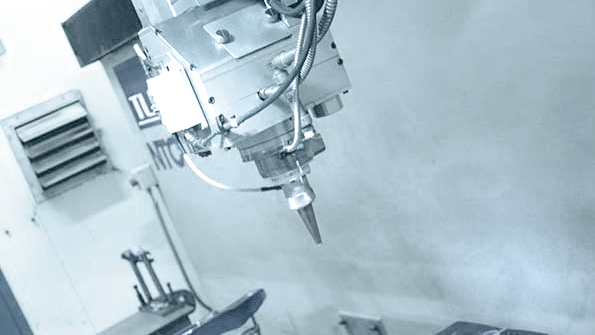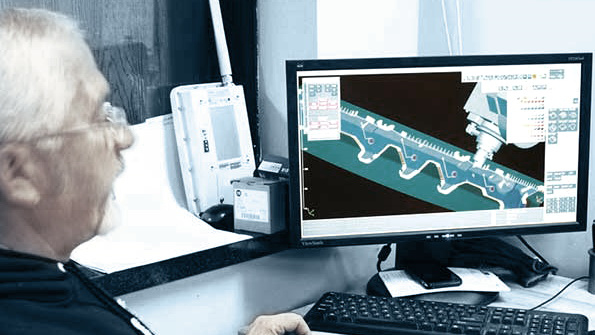-
Software
-
CAM software
- Tebis Automill
- CNC programming
- CNC automation
- CNC simulator
- Multiple setup
- Robotic machining
- CNC drilling
- Deep-hole drilling
- Combined turn-milling
- CNC turning
- Turn-milling
- 2.5D milling
- 3D milling
- 5-axis milling
- Slot milling
- Trimming
- HPC milling
- HFC milling
- Circle-segment cutters
- Sinker EDM
- Wire EDM
- 3D laser cutting
- Laser hardening
- Laser weld cladding
- CAD software
- CAQ software
- MES software
- Products
-
CAM software
- Services
- Consulting
- Sectors
- References
- Company
- News

-
 Home References
Home ReferencesPrecision programming enriches the 3D laser-cutting process
Tebis at Accu-Rite Industries
No company feels the pain of shrinking lead times more than prototype shops. Case in point: Accu-Rite Industries, where the adoption of high-speed 3D laser-cutting technology paired with CAD/CAM programming software represent clear success triggers.
Company
Accu-Rite Industries
Location
Shelby Township, Michigan, United States
Focus
Prototype specialist of seating components and assemblies
Benefits:
- Less Air Time, More Run Time
- Cuts look better and edge quality is optimized
- Loaded with unique and carefully engineered design capabilities
Sector
Machinery and equipment
Published
2015

Interviewee: Kirko Mickovski, Owner
We trust Tebis with our millions of dollars invested in our state-of-the-art laser-cutting equipment.
Kirko Mickovski, Accu-Rite Industries, Shelby Township, MI, United StatesRequirements
Design and manufacture of seating components and assemblies represent some of the trickiest aspects of automobile production. Simply stated, seats challenge engineers as they must simultaneously satisfy goals related to safety and health, as well as driver and passenger comfort. Seating components— including their many stamped and fabricated metal parts—must account for ergonomic considerations, vibration suppression and strength. Precision Programming Enriches the 3D Laser-Cutting Process Key to the remarkable advances made in automotive-seating engineering is prototype development, the specialty of Accu-Rite Industries, Shelby Township, MI. The firm works with several OEMs and Tier One suppliers to develop reclining-mechanism components, slide tracks, shells and frame parts, reinforcing brackets, hinges, latches and locks.
Workshop
Amongst the tools in the firm’s proverbial manufacturing toolbox are, of course, stamping presses (350- to 750-ton hydraulic models), as well as press brakes, machining centers and coordinate-measuring machines. The newest star on its shop floor: a five-axis 3D laser-cutting machine, a TLH-series model from NTC America, with a work envelope of 177 by 45 by 20 in. Equipped with a 2-kW fiber laser, the state-of-the-art workhorse boasts cutting and positional accuracy rated to 0.0015 in., and a pallet changer to optimize throughput. It takes Accu-Rite’s ability to trim stamped prototype parts to a new level of efficiency and quality. “We need the highest levels of accuracy available in the industry,” says Accu-Rite vice president John Loudon, “to keep up with demands from our customers.” Tolerances, he says, often are specified at plus or minus 0.05 mm on stamped parts.
 The newest star on the Accu-Rite shop floor is this five-axis 3D laser-cutting machine, with a work envelope of 177 by 45 by 20 in. and equipped with a 2-kW fiber laser.
The newest star on the Accu-Rite shop floor is this five-axis 3D laser-cutting machine, with a work envelope of 177 by 45 by 20 in. and equipped with a 2-kW fiber laser.The Onus Falls to Programming
The newest NTC machine joins four CO2-laser five-axis cutting machines on the Accu-Rite floor, all primarily used to trim prototype stamped parts. The shop processes mostly high-strength steels (some advanced high-strength steels such as dual-phase alloys) to 3/8 in. thick. Lately, though, notes company president Kirko Mickovski, customers have been opting for aluminum seating components—“a perfect fit for the new fiber-laser system,” Mickovski notes. “The fiber-laser machine cuts aluminum stampings up to four twimes faster than our CO2 laser machines, and cuts twice as fast on steel.” With that much cutting speed at the ready, part of the responsibility for moving work quickly through the shop falls to the laserprogramming function. And Loudon and Mickovski couldn’t be more pleased with the programming solution they invested in several years ago—CAD/CAM software from German-based Tebis (with U.S. operations in Troy, MI). Tebis software, known better for its functionality related to CNC machining, also features a CAM module that drives five-axis laser cutting. Loaded with unique and carefully engineered design capabilities aimed at this tricky application, the software can streamline the cutting process while providing pinpoint accuracy, as well as provide reliable and efficient collision avoidance. It gets clear nods of approval from Accu-Rite management. The seal of approval: “We trust Tebis with our millions of dollars invested in our state-of-the-art laser-cutting equipment,” says Mickovski.
Less Air Time, More Run Time
Among the noted features in the Tebis lasercutting CAM module, as noted by Accu-Rite programmer Mike Winkler: With just a few mouse clicks, programming moves from the CAD part model to cutting-fixture design (with supporting-rib geometry included), and on to cut-path formulation. The software considers cutting-machine and cutting-head kinematics and geometry to eliminate collision hazards, while also minimizing major rotational movements. Winkler employs the software to program all five of the firm’s 3D laser-cutting machines; machine data—physical dimensions as well as cutting-process capabilities—is contained within the Tebis database. Winkler also notes that the CAM software minimizes laser-head approach and retract movements, “while ensuring the head isn’t spinning excessively,” he says. “We’re minimizing ‘air time’ and optimizing cutting time.” With programming and cutting time optimized, quick turnaround to customers becomes less of a worry, say Mickovski and Loudon. “We don’t use kirksite stamping tools, we use steel, because our lot sizes are larger than other types of prototype runs,” says Loudon. “This is because seating parts are safety related. Our part runs are relative large (300 to 400 parts is typical), requiring optimum efficiency from the laser-cutting process."
We recently completed a package of 140 part numbers,” adds Mickovski. “We ran 60,000 parts, and had the job programmed, through tool development and stamping, and then through the laser-cutting department and on to shopping in just 6 weeks.
 Accu-Rite programmer Mike Winkler explains how with just a few mouse clicks, programming moves from the CAD part model to cutting-fixture design (with supporting-rib geometry included), and on to cut-path formulation. The software considers cuttingmachine and cutting-head kinematics and geometry to eliminate collision hazards
Accu-Rite programmer Mike Winkler explains how with just a few mouse clicks, programming moves from the CAD part model to cutting-fixture design (with supporting-rib geometry included), and on to cut-path formulation. The software considers cuttingmachine and cutting-head kinematics and geometry to eliminate collision hazardsHuge Time Savings
With updates in collision avoidance and other features added to Tebis via recent software updates, programming is faster than ever—“maybe 30 percent faster than it was several years ago,” says Winkler, “and the process is more efficient. I’m confident that the programs developed in the office, offline, will run the first time on the shop floor. That means we’re not going back and forth from programming to production to fine-tune the lasers. This way, the cutting machines can work on the next job, making money, rather than waiting for program tweaks.” Winkler says that he can program some of the shop’s simpler parts in just 15 min., and complex parts take only an hour or so of programming time. Out on the floor, Accu-Rite laser-machine operators trust that Winkler’s programs will run correctly, the first time. “In the past,” says Winkler, “they used to dry-run every job with the cutting head retracted to a safe position, to ensure the programs were sound, and then make adjustments as needed. They no longer have to perform that wasteful step, which represents a huge time savings--probably 30 min. on every job.” Should the operator on the floor, in that rare instance, need to make any modifications to the NC program at the machine, Winkler notes that those modifications can easily be reversed back into the NC job via its relatively simple editing functions.
Digital Data
In addition to laser-cutting productivity gains through the use of Tebis software, Winkler also notes improvements in cut quality and in eliminating extra and excessive laser-head movement. This adds up to minimal, if any, secondary operations to clean up cut edges, and reduces maintenance concerns with the cutting equipment. “Compared to other CAM programs that triangulate the data to derive cut paths,” says Winkler, who has been programming Accu-Rite’s lasers since the firm brought the technology inhouse in 1998, “Tebis uses digital data. This provides greatly improved blending of data points. So, our cuts look better and edge quality is optimized—we rarely if ever have to post-cut sand or machine the cut edges before shipping the parts off to our customers.” Also, the laser-cutting machines run smoothly, with no head whipping or excessive movement, thanks to the built-in knowledge in the Tebis database. The software, for example, automatically monitors the cutting machine’s kinematic properties, including tilting limits and preferred starting position. This not only allows it to calculate minimal yet sufficient evasive movements to avoid collisions, but also to minimize head movement. This increases run time while helping to reduce the amount of maintenance we have to perform on the cutting machines.”
